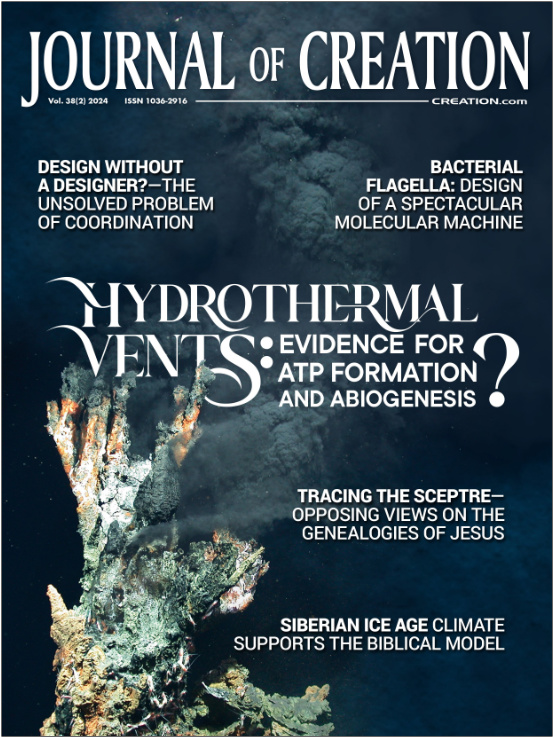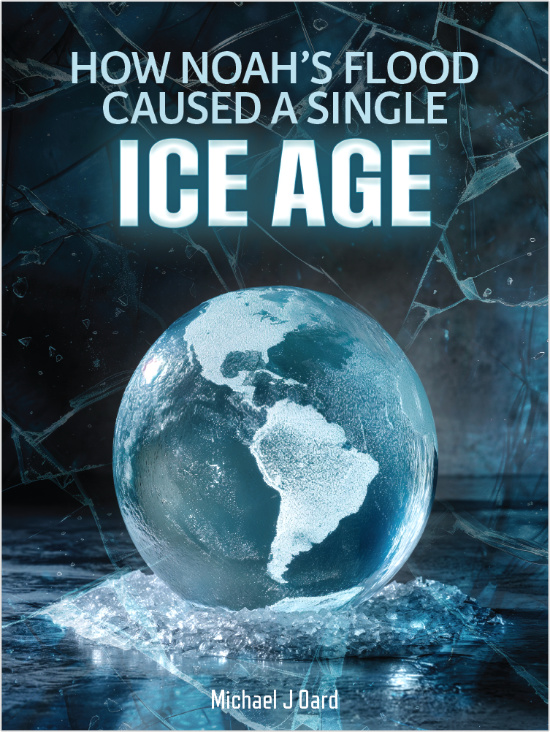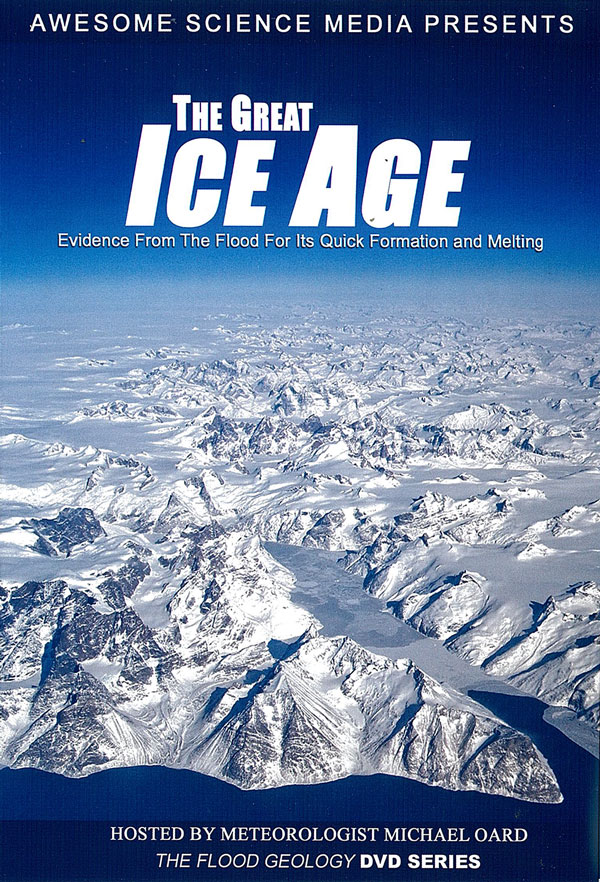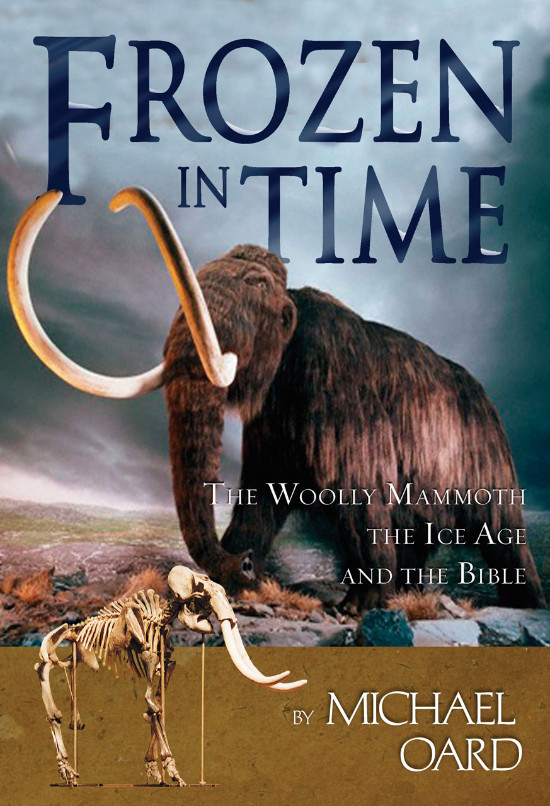Journal of Creation 38(2):3–6, August 2024
Browse our latest digital issue Subscribe
Siberian Ice Age climate supports the biblical model
Uniformitarian scientists have conventionally predicted very cold temperatures, winter and summer, and low precipitation during their last ice age, including in Siberia. The paleoenvironment in Siberia would have been a polar desert:
“Were the last glacial landscapes of Siberia treeless and sparsely vegetated and the climate colder all year round than at present, as suggested by some key reconstructions … and climate model simulations, or do these conventional views require adjustment and revision?”1
Tarasov et al. view the Ice Age climate during the Upper Paleolithic (UP) from 50,000–10,000 years ago differently than most other conventional scientists. They have macrofossils, the stomach contents of frozen animals, pollen cores from lakes, etc., to back up their claims.
Many more questions for uniformitarian scientists
Siberian researchers have produced many confusing interpretations with a growing number of questions:2 “However, the list of questions has not become shorter and the gap between ‘what do we know and what would we like to know’ is far from being closed.”1 I also have many questions about the uniformitarian scenario, such as:
- Why would there be a grassland environment with a huge number and diversity of mammals?
- Why would humans migrate through the far north under very cold conditions 10–50 kyr ago as believed by conventional scientists?
- Why would some people settle in Siberia during the UP?
- Could the huge variety of animals, many of them now extinct or living farther south, have lived in Siberia during the paleoclimate and paleoenvironment envisioned by uniformitarian scientists?
These sorts of unanswered questions do not unilaterally overthrow the whole long-age approach to ice ages. However, in revealing potential inadequacies in their current climate models, they also help to generate concept space for considering other interpretive frameworks, such as a biblical approach to ice age data.
Accurate ‘ages’ required
Part of uniformitarian scientists’ problem is their ‘dates’. Accurate dates are required in order to understand the history of events in Siberia, and if they are not correct, the secular history of events is also inaccurate:
“Robustly dated continuous (or even semi-continuous) terrestrial proxy records, which represent environmental and climatic conditions of Northern Asia ca. 50‒10 cal kyr BP [before present], are rare. … The problems of generating such records [terrestrial proxy records], however, are manifold, including chronological control … significant technical challenges, financial considerations, labour and time investments necessary for sediment core recovery and detailed analysis.”3
Based on their dates, Tarasov et al. showed other surprising climatic paradoxes, such as that the Mediterranean Sea area supposedly became depopulated during the Ice Age, while Siberia increased its population.1 They asked, “Were the last glacial environments in Siberia less hostile to UP hunter-gatherers than those in the Mediterranean region?”1 And their tentative solution to this question involved precise age determinations for climatic regimes:
“The episode of further cooling and drying of the regional climate ca. 49–47.7 cal kyr BP … could have been a potential factor that triggered the movement of a part of the AMH population north-eastwards.”4
Paleoenvironmental information contradicts uniformitarian climate models
Uniformitarian climate simulations produce very cold winter and summer temperatures and dry conditions, with ice often over the lowlands of Siberia and Alaska. For instance, one model produced temperatures 20–40 °C colder over the ice sheets than those areas today, with up to 20 °C colder temperatures over large areas south of the ice sheets.5
However, the data on the ground in Siberia tell a different story, as indicated by Tarasov et al. A wealth of paleoenvironmental data is available for the UP in Siberia. Most of the proxy data show a huge number of diverse mammals that do not agree with the assumed very cold ice age paleoclimate:
“However, the fossil animal records from the northern and southern regions [of Siberia] are in line with the botanical and aDNA [ancient DNA] records in not supporting desert environments in Northern Asia between 50 and 10 cal kyr BP, not even during the LGM [Last Glacial Maximum].”6
“The existence of such environments [ice-free and well-vegetated with a large number of animals] in Siberia particularly in its coldest northern regions, during the UP cannot be adequately explained by the still widely accepted ‘year-round colder-than-present climate scenario’ [emphasis added].”6
The number of animals has been compared to the enormous number of animals in the Serengeti of Africa:
“We calculate, based on animal skeleton density in frozen soils of northern Siberia, that mammoth-steppe animal biomass and plant productivity, even in these coldest and driest of the planet’s grasslands were close to those of an African savanna.”7
For creation scientists, we can take the pollen data from two lakes8 in a relative sense, since the deeper parts of the cores are older than the shallower parts. A core from southern Siberia shows mostly sagebrush and grass with more tree pollen toward the bottom and the top. Another core from central Siberia was dominated by grass and sedges throughout, with more tree pollen at the top. Many grass roots are found in the yedomas: “in yedoma numerous thin grass roots are preserved”.9 This means that when the loess of the yedoma was being deposited, grass was growing.
It all adds up to the conditions suggested by Guthrie of the ‘mammoth steppe’.10 Such an environment occurred over a wide area: “Their results confirm that large areas of Northern Asia presently occupied by boreal forests … were much more open.”11
Uniformitarian scientists attempt to claim such a grass environment was from a cold steppe and tundra climate, but the pollen data can be interpreted differently, for instance a mild steppe climate:
“However, pollen-based temperature reconstructions for the glacial period are inconclusive, since herbaceous pollen taxa identified at the genus or family level have very broad bioclimatic tolerances and can be found in cold and warm climates.”6
Such a grassland with diverse mammals, as many as 40 species, required diverse types of ground vegetation.12 Zimov et al. reinforce this conclusion and add that the soils were fertile.7 Practically all the mammals were grazers, eating grass. Those that fed from a more swampy environment, such as reindeer and moose, did not arrive until the end of the Ice Age.13 It was the end of the Ice Age when Siberia had a radical climate change at the Pleistocene/Holocene transition.12 Many of the 40 types of animals indicated warmer conditions than today, especially in winter. Although there are local areas of grass in Siberia today, most of it is swampy. It is the permafrost that causes the swamps, and the grassland implies little or no permafrost early in the Ice Age, as expected within the biblical Ice Age model.16,17
One of the most tell-tale mammals is the Saiga antelope (figure 1) that is found in Siberian permafrost, as well as in unglaciated areas of Alaska and the Yukon territory, while today they inhabit the steppes of Kazakhstan and vicinity. The Saiga antelope has small hooves and cannot negotiate permafrost areas with bogs; this implies wide open, solid plains.
Humans supposedly migrated and settled in Siberia during the harshest Ice Age climate
Scientists believe UP humans migrated to all continents 10–50 ka ago, when the climate was the harshest:
“The Upper Palaeolithic (UP) period, broadly dated to between 50,000 and 10,000 years ago, is of particular interest … as it witnessed the climatically harshest and most variable part of the last glacial epoch … when AMH [anatomically modern humans] spread to all continents, with the exception of ice-covered Antarctica.”14
During the whole UP interval, humans continued to move and even settle in Siberia with the greatest concentration at the LGM, which is implausible given the conventionally assumed very cold and harsh desert paleoclimate and paleoenvironment.
“This reconstruction [cold, desert paleoenvironment] shows hostile environments that are unsuitable for large herbivores, but also for human habitation during the entire MUP [Middle Upper Paleolithic 28/25–19/18 kyr BP] and, thus, contradicts the recent archaeological site date for this interval.”15
It does not seem feasible that humans would migrate through Siberia into Alaska and down the ice-free corridor of the Yukon Territory and Alberta, Canada, into the central United States during the very cold, polar desert uniformitarian ice age conditions. They certainly would not settle in Siberia.
Creation science model of the Ice Age
I have suggested a much different climate for the Ice Age from uniformitarian conceptions.16,17 It would start out with mild winters, cooler summers, and much more precipitation early in the Ice Age caused by warm oceans, from pole to pole and top to bottom, and much Flood and post-Flood volcanism. Mild winters result from a warm ocean and the release of latent heat during condensation. This would probably be greatest during winter due to greater storm activity. The warmer the sea surface temperature, the greater the evaporation at mid- and high latitudes compared to today. Volcanic aerosols in the stratosphere and volcanic ash on the ground would reflect a proportion of the sunlight back into space, cooling the land, especially during summer. Minimal cooling would occur over the oceans because of its high heat capacity. Abundant mid- and high-latitude moisture would produce heavy snowstorms at high latitudes and certain mid-latitude areas. Heavy rain would occur over most non-glaciated land.
However, the post-Flood Ice Age climate was highly dynamic. As volcanism waned, summers would warm. Evaporation and conductive cooling would cool the oceans with time, causing less evaporation and precipitation. By the end of the Ice Age, winters would be much colder than those today, with warming summers and little precipitation. Little snow would be added to the ice sheets during the year, and summer temperatures would melt much ice. I have roughly estimated that the time to glacial maximum would be about 500 years, and the time to melt the ice sheets about 200 years, for a post-Flood rapid Ice Age of roughly 700 years.
After the ice sheets melted, temperatures warmed in the early Holocene, melting some of the permafrost in places, forming a thermokarst terrain with hills (yedomas) and basins (alases), sometimes with lakes.18
Ice Age modelling
Gollmer has attempted to model ice sheet growth based on a warm ocean and various volcanic aerosol loading scenarios, using the Goddard Institute of Space Studies (GISS) model.19,20,21 His model has progressed over the years, and the latest presentation was run out to 397 years with no initial Greenland and Antarctic ice sheets.21 The average ocean temperature was set at 24 °C, since he previously found that 30 °C seemed too warm. The volcanic aerosol loading had a perpetual optical depth of 2.0, which means that only 1/5 of the solar radiation hits the earth’s surface. The latest model was even further from creating an ice age in that the high-latitude oceans cooled rapidly, with sea ice quickly forming and becoming extraordinarily thick. The many millions of animals in Siberia, Alaska, and the northwest Yukon Territory contradict this finding. Something seems wrong in the sea ice module. No land bridge is formed between Siberia and Alaska for animal migration. Ice thickness builds up to only 5 m, far from what occurred during the Ice Age.
Gollmer’s model strongly shows the effect of the warm ocean, which, in his model, causes the continents to be too warm for glaciation. However, there seems to be a problem in his model with the initial condition of the volcanism. Nonetheless, it is very difficult to know what exactly to use for a volcanic initial condition. Only two modifications seem able to cause the higher continental latitudes to be cold enough to build the ice sheets: (1) a higher albedo (reflectivity) of snow, especially fresh snow; and (2) an increase of the albedo of the continents, since researchers discovered that volcanic ash on the ground is about as reflective as snow.22 The initial aerosol optical depth can then be greatly reduced so that more sunshine penetrates the surface but much of it is reflected back, which has the added benefit of not retarding photosynthesis. I look forward to more iterations of his model, which will undoubtedly change some of the aspects of my Ice Age model.
Where do the warmer summers fit in the biblical Ice Age?
The lake cores indicate the grass, sedges, and sagebrush paleoenvironment changed at the end of the Ice Age. More tree pollen shows up in southern Siberia based on the top of their pollen interval at 10 ka. The researchers do conclude:
“This contradicts earlier reconstructions of very low summer temperatures (i.e., close to 0 °C) during the last cold stage across the northern Siberian lowlands … . Using an indicator-species approach, Kienast et al. (2005) reconstructed mean July temperatures above 12 °C for most of the last cold stage in the study area, where modern mean July temperatures are about 7 °C.”4
The uniformitarian time period of 10–50 kyr ago could apply to the middle and end of the post-Flood Ice Age. The animals would be especially numerous during the middle Ice Age but be dying out or migrating out of Siberia at the end of the Ice Age because of the winters becoming much colder than those today, with the rapid increase in permafrost. Continents over the earth would have cooler summers during the early part of the Ice Age, but this would apply mainly to the interiors far from warm onshore flow from off the warm oceans. This could be the case with Siberia, with warm onshore flow from the Arctic and north Pacific Oceans (figure 2).
Conclusions
Tarasov et al. have made a compelling case for a fundamental contradiction between conventional long-age ice age climate models and the paleoclimatic data in Siberia. Their climate models clearly need revision. However, the paleoclimate data they cite matches what we would expect from mid-to-late Ice Age conditions in the biblical framework.
References and notes
- Tarasov, P.E., Leipe, C., and Wagner, M., Environments during the spread of anatomically modern humans across Northern Asia 50–10 cal kyr BP: what do we know and what would we like to know?, Quaternary International 596:155–170, 2021; p. 156. Return to text.
- Tarasov et al., ref. 1, pp. 155–170. Return to text.
- Tarasov et al., ref. 1, p. 159. Return to text.
- Tarasov et al., ref. 1, p. 166. Return to text.
- Charbit, S., Ritz, C., Philippon, G., Peyaud, V., and Kageyama, M., Numerical reconstructions of the Northern Hemisphere ice sheets through the last glacial-interglacial cycle, Climates of the Past 3:15–37, 2007. Return to text.
- Tarasov et al., ref. 1, p. 165. Return to text.
- Zimov, S.A., Zimov, N.S., Tikhonov, A.N., and Chapin III, F.S., Mammoth steppe: a high-productivity phenomenon, Quaternary Science Reviews 57:26–45, 2012; p. 26. Return to text.
- Tarasov et al., ref. 1, p. 161. Return to text.
- Zimov et al., ref. 7, p. 43. Return to text.
- Guthrie, R.D., Frozen Fauna of the Mammoth Steppe: The story of Blue Babe, The University of Chicago Press, Chicago, IL, 1990. Return to text.
- Tarasov et al., ref. 1, p. 163. Return to text.
- Davydov, S., Davydova, A., Schelchkova, M., Makarevich, R., Fyodorov-Davydov, D., Loranty, M., and Boeskorov, G., Essential mineral nutrients of the high-latitude steppe vegetation and the herbivores of mammoth fauna, Quaternary Science Reviews 228(106073):1–15, 2020. Return to text.
- Zimov et al., ref. 7, p. 27. Return to text.
- Tarasov et al., ref. 1, p. 155. Return to text.
- Tarasov et al., ref. 1, p. 160. Return to text.
- Oard, M.J., Frozen in Time: Woolly mammoths, the Ice Age, and the biblical key to their secrets, Master Books, Green Forest, AR, 2004. Return to text.
- Oard, M.J., How Noah’s Flood Caused a Single Ice Age, Creation Book Publishers, Powder Springs, GA (in press). Return to text.
- Brosius, L.S., Walter Anthony, K.M., Treat, C.C., Lenz, J., Jones, M.C., Bret-Harte, M.S., and Grosse, G., Spatiotemporal patterns of northern lake formation since the Last Glacial Maximum, Quaternary Science Reviews 253(106773):1–12, 2021. Return to text.
- Gollmer, S.M., Initial conditions for a post-Flood rapid Ice Age; in: Horstemeyer, M. (Ed.), Proceedings of the Seventh International Conference on Creationism, Creation Science Fellowship, Pittsburgh, PA, Article 18, 2013. Return to text.
- Gollmer, S.M., Effects of aerosol distribution on precipitation patterns needed for a rapid ice age; in: Whitmore, J.H. (Ed.), Proceedings of the Eight International Conference on Creationism, Creation Science Fellowship, Pittsburgh, PA, pp. 695–706, 2018. Return to text.
- Gollmer, S.M., A feasibility of a rapid Ice Age and transition to ice sheet growth; in: Whitmore, J.M. (Ed.), Proceedings of the Ninth International Conference on Creationism, Cedarville University, Cedarville, OH, pp. 267–279, 2023. Return to text.
- Jones, M.T., Sparks, R.S.J., and Valdes, P.J., The climatic impact of supervolcanic ash blankets, Climate Dynamics 29:553–564, 2007. Return to text.





Readers’ comments
Comments are automatically closed 14 days after publication.